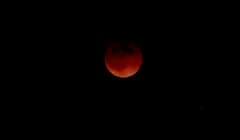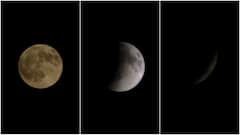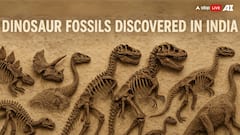Mysterious Interstellar Object 'Oumuamua, The First Known Visitor From Outside Solar System, Was A Comet: Study
Due to its small size, some believed that 'Oumuamua was an asteroid, rather than a comet. Some even suggested that 'Oumuamua was an alien spaceship. Now, a new study suggests that it was a comet.

A mysterious interstellar object dubbed 'Oumuamua became the first known visitor from outside the solar system in 2017. In other words, 'Oumuamua was the first known object other than dust grains to visit our solar system from another star. 'Oumuamua sparked a lot of debate, because scientists were unable to determine what kind of object it was. It was shaped like a pancake, and did not have a bright dust tail like most comets. Due to its small size, some believed that it was an asteroid, rather than a comet. Some even suggested that 'Oumuamua was an alien spaceship.
‘Oumuamua was a comet, after all
Now, a new study, conducted by researchers at University of California, Berkeley, and Cornell University, has offered a simple explanation for 'Oumuamua's weird orbit: a physical mechanism likely common among many ice comets. This suggests that 'Oumuamua was a comet, after all.
The study describing the findings was recently published in the journal Nature.
Why did ‘Oumuamua mysteriously deviate from its hyperbolic path around the Sun?
As the comet warmed up in the sunlight, it outgassed hydrogen. This is a physical mechanism common among many icy comets, and could be the reason behind 'Oumuamua's mysterious deviations from a hyperbolic path around the Sun.
What made ‘Oumuamua different from comets in the solar system?
'Oumuamua was different from every other well-studied comet in the solar system due to its size. Since 'Oumuamua was so small, its gravitational deflection around the Sun was slightly altered by the tiny push created when hydrogen gas spurted out of the gas.
According to the study, 'Oumuamua showed a notable non-gravitational acceleration.
The acceleration of 'Oumuamua is due to the release of entrapped molecular hydrogen that formed through energetic processing of a water-rich icy body, the study said.
Most comets are dirty snowballs that periodically approach the Sun from the outer reaches of the solar system, and eject water and other molecules when warmed by sunlight. This produces a bright halo or coma around the comet, and often tails of gas and dust.
The ejected gases serve as thrusters on a spacecraft and give the comet a tiny kick that alters the object's trajectory slightly from its elliptical orbit. This mechanism is typical of other solar system objects, such as asteroids and planets.
When 'Oumuamua was discovered, it had no coma or tail. Also, it was too small and too far from the Sun to capture enough energy to eject much water. These observations led astronomers to speculate wildly about 'Oumuamua's composition and what was pushing it outward. Astronomers wondered if 'Oumuamua was a hydrogen iceberg outgassing hydrogen gas, a large fluffy snowflake pushed by light pressure from the Sun, a light sail created by an alien civilisation, or a spaceship under its own power.
‘Oumuamua was irradiated by cosmic rays
According to the study, 'Oumuamua began as an icy planetesimal that was irradiated at low temperatures by cosmic rays during its interstellar journey. 'Oumuamua experienced warming during its passage through the solar system. As a result, hydrogen gas was produced from the water ice inside the comet.
In a statement released by University of California, Berkeley, Jennifer Bergner, the lead author on the paper, said a comet travelling through the interstellar medium basically is getting cooked by cosmic radiation, forming hydrogen as a result. She said the researchers' thought was that if this was happening, could the object actually trap the hydrogen in the body, so that when it entered the solar system and was warmed up, it would outgas that hydrogen.
The trapped hydrogen could quantitatively produce the force that is needed to explain the non-gravitational acceleration.
Bergner found that experimental research published in the 1970s, 1980s, and 1990s demonstrated that when ice is irradiated by high-energy particles similar to cosmic rays, molecular hydrogen is abundantly produced, and trapped within the ice. According to the University of California, Berkeley, cosmic rays can penetrate tens of metres into ice, converting a quarter or more of the water into hydrogen gas.
Since ‘Oumuamua was small, non-gravitational acceleration could have been possible
Bergner said that for a comet several kilometres across, the outgassing would be from a really thin shell relative to the bulk of the object. As a result, one would not necessarily expect that to be a detectable effect, both compositionally and in terms of acceleration. However, since 'Oumuamua was so small, the researchers believe that the comet actually produced sufficient force to power the non-gravitational acceleration that deviated the object from its hyperbolic path around the Sun.
According to the University of California, Berkeley, astronomers observing 'Oumuamua noticed a slight acceleration away from the Sun, which was larger than seen for asteroids, and more characteristic of comets.
How water ice in ‘Oumuamua was converted into hydrogen
Comets are usually seen with a glowing, gaseous coma due to the water and gases ejected from its surface when it approaches the Sun.
However, astronomers could not detect any coma, outgassed molecules or dust around 'Oumuamua. Moreover, the solar energy hitting the object would be insufficient to sublimate water or organic compounds from its surface to give it the observed non-gravitational kick.
Considering the amount of incoming solar energy, only hyper volatile gases such as hydrogen, nitrogen and carbon monoxide could provide enough acceleration to match observations.
The authors, Bergman and Darryl Seligman, ruled out the possibilities of the object being a hydrogen iceberg, or a solid body composed of hydrogen, nitrogen or carbon monoxide because such bodies have never been observed before, and a solid hydrogen body could not survive for 100 million years in interstellar space.
Therefore, Bergner thought that the outgassing of hydrogen entrapped in ice could be sufficient to accelerate 'Oumuamua. She studies the interaction of very cold ice, chilled to five or 10 degrees Kelvin, with the kinds of energetic particles and radiation found in the interstellar medium. The temperature of the interstellar medium is five or 10 degrees.
Previous studies have shown that high-energy electrons, protons and heavier atoms could convert water ice into molecular hydrogen, the fluffy snowball structure of a comet could entrap the has in bubbles within the ice, and when warmed by the heat of the Sun, the ice anneals, or changes from an amorphous to a crystal structure, and forces the bubbles out, releasing hydrogen gas.
Bergner and Seligman calculated that the ice at the surface of a comet could emit enough gas to affect the orbit of a small comet like 'Oumuamua.
'Oumuamua was slightly reddish. Researchers estimate that the size of 'Oumuamua was about 115 by 111 by 19 metres. The relative dimensions were certain, but astronomers could not be sure of the actual size because 'Oumuamua was too small and distant for telescopes to resolve.
Researchers estimated the size of 'Oumuamua from its brightness and how the brightness changed as the comet tumbled.
All the comets observed in the solar system to date, from the short-period comets originating in the Kuiper belt to the long-period comets from the more distant Oort cloud, have ranged in size from around one kilometre to hundreds of kilometres across.
What do comets tell us about the solar system?
Since comets are icy rocks left over from the formation of the solar system 4.5 billion years ago, they tell scientists about the conditions that existed when the solar system formed. One can obtain clues to conditions around other stars surrounded by planet-forming disks by studying interstellar comets.
Bergner said comets preserve a snapshot of what the solar system looked like when it was in the state of evolution that protoplanetary disks are now, and studying them is a way to look back at what the solar system used to look like in the early formation stage.
Discovery of ‘Oumuamua
Astronomers using the Pan-STARRS1 Telescope, on the island of Maui, first noticed what they thought was either a comet or an asteroid, on October 19, 2017. From the object's tilted orbit and high speed, the astronomers interpreted it to have come from outside the solar system, and named it 'Oumuamua, which means "a messenger from afar arriving first" in Hawaiian.







































